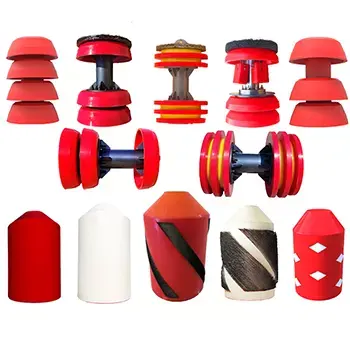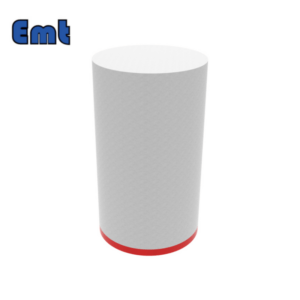Description

Compact structure
The whole system is very tightly held together, the mandrel and the tail flange are molded together, all the cleaning bowls, isolation rings, brushes, and other components are stacked on the front, and the front friction and pressure are acting backward on the shaft. If the front fastening nut is loose, the whole system will never unravel. The mandrel can also be fully tensioned and passed through the pipe when component thickness and structure change.
Good cleaning effect and uniform wear
The mandrel is made of rigid, hollow polyurethane, which reduces the weight of the entire system by more than 35% compared to the metal structure. The bending and cleaning effect of the system is better than that of the steel shaft system. Because of its lightweight, the leather bowl is not easy to deform in the pipeline, so the pipeline cleaning is uniform so that the components wear evenly. The hollow polyurethane shaft is easier to bend than the steel shaft, and the ability to pass is strong. When the bend turns sharply, the risk of being touched and damaged is small, and the pipe will never be stuck in the pipe because the curvature radius of the pipe bend is small.
Can be prepared and assembled according to user needs
The system can be formulated or combined with components (such as wire brush polyurethane scraper or steel scraper and other auxiliary cleaning components) as required by the user. It can be completely assembled or reassembled by one person operating independently. The combined system can complete pipeline cleaning, water removal, measurement, product isolation, wax removal, rust removal, pipeline coating, and water pressure tests. The applicable pipe size range is DN259~DN720
The cleaning pig is made up of two or three leather bowls formed by polyurethane integral touch molding. It can also be equipped with a wire brush or polyurethane scraper, steel blade scraper, and other auxiliary cleaning parts, its characteristics are as follows:
Good flexibility, strong sealing
The structure is designed to make two or three leather bowls sealed, thus improving the flexibility and tightness of the pig. Allow through any form of pipe joint welds, valves, and elbows.
Lightweight, high-strength
This type of pig is more than 50% lighter and has no loss of strength or life compared to other metal pigging structures.
The solid and durable polyurethane pig is an order of magnitude stronger than a metal pig, with additional head reinforcement if needed.
Economic integration, no expensive spare parts, neither scattered in the pipe nor stuck in the pipe. No need for maintenance, with good performance and price ratio.
It can be used for pipeline cleaning, scraping wax, descaling, internal coating anti-corrosive layer, but also for pipeline emptying, filling, hydraulic test, and fluid isolation. The most economical application size ranges from DN50 to DN159

The role of the pig
1. Natural gas pipeline in operation: remove water, light oil, methane hydrate, iron oxide, carbide dust, carbon disulfide, hydrosulfuric acid, and other corrosive substances inside the pipeline; Reduce the corrosion damage of corrosive substances to the inner wall of the pipeline; Re-define the pipeline direction; Detection of pipeline deformation; Check the integrity rate of valves along the line; Reduce working back pressure.
2. Crude oil pipelines in operation: pigging before testing in pipelines, and pigging of oil pipelines in low flow intermittently; Remove the condensate, wax, and scale inside the pipeline to reduce the oil back pressure, reduce the friction, and reduce the oil temperature.
3. Chemical materials and edible oil pipelines: clean the pipelines of cohesive materials; Separate different pipe transport media to achieve single pipe multi-product transport and metering pipe transport media.
New pipeline pigging:
4. Sectional pigging line sweeping pressure test: remove pipeline debris, rust, drainage, and exhaust.
5. Total pigging pressure test: test pipeline deformation and construction quality. Exhaust before the hydrostatic test, drainage before production, drying, and medium isolation.
6. Water transmission and injection pipeline: remove scale and sediment.

Working principle
In the pipeline operation, the corresponding pipeline cleaner series should be set up according to the operation requirements. The outer edge of the pipe is sealed with the inner wall of the pipe. The pressure difference generated by the conveying pipe is used as the driving force to push the pipe cleaner to run along the pipe. Scale or sediment in the pipe can be removed by scraping and scouring by the pig itself or its machinery and tools.
The selection of pig is a multi-objective and multi-factor decision-making problem, which mainly determines the mechanical strength, wear resistance, adsorption, reactivity of the conveying medium in the pipeline and the bearing capacity of the pig, specifically as follows:
(1) Pigging target. Whether the pipe is cleaning fluid or solid impurities and dirt, and predict the amount of dirt. If more sediment impurities are expected, natural gas pipelines can use pigging with drain holes to blow sand through the drain holes to avoid clogging.
(2) Pipeline life cycle stage. The new pipeline is used for residue cleaning, preliminary measurement, pressure testing, drying, and commissioning. Piping is operated to remove wax deposits and dirt, isolate media and inhibit corrosion. Pipeline shutdown and abandonment refers to the removal of medium and filling of inert gas.
(3) Determine the driving medium (oil, water, gas) characteristics of pigging.
(4) Pig interference. Consider minimum bend radius and bend Angle, minimum and maximum bore diameter, branch connection, height variation along the line, and valve/tee/elbow type, position, and size along the line.
(5) Pipeline cleaning process. The range of driving pressures provided by the pipe (maximum allowable working pressure, working pressure, temperature parameter variation) as well as the range of possible speeds and maximum distances of the pipe cleaners.
polyurethane pig





Reviews
There are no reviews yet.